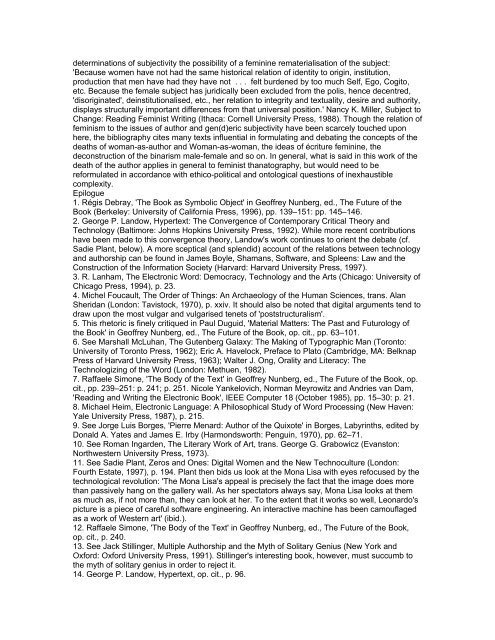Create successful ePaper yourself
Turn your PDF publications into a flip-book with our unique Google optimized e-Paper software.
determ<strong>in</strong>ations <strong>of</strong> subjectivity <strong>the</strong> possibility <strong>of</strong> a fem<strong>in</strong><strong>in</strong>e rematerialisation <strong>of</strong> <strong>the</strong> subject:<br />
'Because women have not had <strong>the</strong> same historical relation <strong>of</strong> identity to orig<strong>in</strong>, <strong>in</strong>stitution,<br />
production that men have had <strong>the</strong>y have not . . . felt burdened by too much Self, Ego, Cogito,<br />
etc. Because <strong>the</strong> female subject has juridically been excluded from <strong>the</strong> polis, hence decentred,<br />
'disorig<strong>in</strong>ated', de<strong>in</strong>stitutionalised, etc., her relation to <strong>in</strong>tegrity <strong>and</strong> textuality, desire <strong>and</strong> authority,<br />
displays structurally important differences from that universal position.' Nancy K. Miller, Subject to<br />
Change: Read<strong>in</strong>g Fem<strong>in</strong>ist Writ<strong>in</strong>g (Ithaca: Cornell University Press, 1988). Though <strong>the</strong> relation <strong>of</strong><br />
fem<strong>in</strong>ism to <strong>the</strong> issues <strong>of</strong> author <strong>and</strong> gen(d)eric subjectivity have been scarcely touched upon<br />
here, <strong>the</strong> bibliography cites many texts <strong>in</strong>fluential <strong>in</strong> formulat<strong>in</strong>g <strong>and</strong> debat<strong>in</strong>g <strong>the</strong> concepts <strong>of</strong> <strong>the</strong><br />
deaths <strong>of</strong> woman-as-author <strong>and</strong> Woman-as-woman, <strong>the</strong> ideas <strong>of</strong> écriture fem<strong>in</strong><strong>in</strong>e, <strong>the</strong><br />
deconstruction <strong>of</strong> <strong>the</strong> b<strong>in</strong>arism male-female <strong>and</strong> so on. In general, what is said <strong>in</strong> this work <strong>of</strong> <strong>the</strong><br />
death <strong>of</strong> <strong>the</strong> author applies <strong>in</strong> general to fem<strong>in</strong>ist thanatography, but would need to be<br />
reformulated <strong>in</strong> accordance with ethico-political <strong>and</strong> ontological questions <strong>of</strong> <strong>in</strong>exhaustible<br />
complexity.<br />
Epilogue<br />
1. Régis Debray, '<strong>The</strong> Book as Symbolic Object' <strong>in</strong> Ge<strong>of</strong>frey Nunberg, ed., <strong>The</strong> Future <strong>of</strong> <strong>the</strong><br />
Book (Berkeley: University <strong>of</strong> California Press, 1996), pp. 139–151: pp. 145–146.<br />
2. George P. L<strong>and</strong>ow, Hypertext: <strong>The</strong> Convergence <strong>of</strong> Contemporary Critical <strong>The</strong>ory <strong>and</strong><br />
Technology (Baltimore: Johns Hopk<strong>in</strong>s University Press, 1992). While more recent contributions<br />
have been made to this convergence <strong>the</strong>ory, L<strong>and</strong>ow's work cont<strong>in</strong>ues to orient <strong>the</strong> debate (cf.<br />
Sadie Plant, below). A more sceptical (<strong>and</strong> splendid) account <strong>of</strong> <strong>the</strong> relations between technology<br />
<strong>and</strong> authorship can be found <strong>in</strong> James Boyle, Shamans, S<strong>of</strong>tware, <strong>and</strong> Spleens: Law <strong>and</strong> <strong>the</strong><br />
Construction <strong>of</strong> <strong>the</strong> Information Society (Harvard: Harvard University Press, 1997).<br />
3. R. Lanham, <strong>The</strong> Electronic Word: Democracy, Technology <strong>and</strong> <strong>the</strong> Arts (Chicago: University <strong>of</strong><br />
Chicago Press, 1994), p. 23.<br />
4. Michel <strong>Foucault</strong>, <strong>The</strong> Order <strong>of</strong> Th<strong>in</strong>gs: An Archaeology <strong>of</strong> <strong>the</strong> Human Sciences, trans. Alan<br />
Sheridan (London: Tavistock, 1970), p. xxiv. It should also be noted that digital arguments tend to<br />
draw upon <strong>the</strong> most vulgar <strong>and</strong> vulgarised tenets <strong>of</strong> 'poststructuralism'.<br />
5. This rhetoric is f<strong>in</strong>ely critiqued <strong>in</strong> Paul Duguid, 'Material Matters: <strong>The</strong> Past <strong>and</strong> Futurology <strong>of</strong><br />
<strong>the</strong> Book' <strong>in</strong> Ge<strong>of</strong>frey Nunberg, ed., <strong>The</strong> Future <strong>of</strong> <strong>the</strong> Book, op. cit., pp. 63–101.<br />
6. See Marshall McLuhan, <strong>The</strong> Gutenberg Galaxy: <strong>The</strong> Mak<strong>in</strong>g <strong>of</strong> Typographic Man (Toronto:<br />
University <strong>of</strong> Toronto Press, 1962); Eric A. Havelock, Preface to Plato (Cambridge, MA: Belknap<br />
Press <strong>of</strong> Harvard University Press, 1963); Walter J. Ong, Orality <strong>and</strong> Literacy: <strong>The</strong><br />
Technologiz<strong>in</strong>g <strong>of</strong> <strong>the</strong> Word (London: Methuen, 1982).<br />
7. Raffaele Simone, '<strong>The</strong> Body <strong>of</strong> <strong>the</strong> Text' <strong>in</strong> Ge<strong>of</strong>frey Nunberg, ed., <strong>The</strong> Future <strong>of</strong> <strong>the</strong> Book, op.<br />
cit., pp. 239–251: p. 241; p. 251. Nicole Yankelovich, Norman Meyrowitz <strong>and</strong> Andries van Dam,<br />
'Read<strong>in</strong>g <strong>and</strong> Writ<strong>in</strong>g <strong>the</strong> Electronic Book', IEEE Computer 18 (October 1985), pp. 15–30: p. 21.<br />
8. Michael Heim, Electronic Language: A Philosophical Study <strong>of</strong> Word Process<strong>in</strong>g (New Haven:<br />
Yale University Press, 1987), p. 215.<br />
9. See Jorge Luis Borges, 'Pierre Menard: <strong>Author</strong> <strong>of</strong> <strong>the</strong> Quixote' <strong>in</strong> Borges, Labyr<strong>in</strong>ths, edited by<br />
Donald A. Yates <strong>and</strong> James E. Irby (Harmondsworth: Pengu<strong>in</strong>, 1970), pp. 62–71.<br />
10. See Roman Ingarden, <strong>The</strong> Literary Work <strong>of</strong> Art, trans. George G. Grabowicz (Evanston:<br />
Northwestern University Press, 1973).<br />
11. See Sadie Plant, Zeros <strong>and</strong> Ones: Digital Women <strong>and</strong> <strong>the</strong> New Technoculture (London:<br />
Fourth Estate, 1997), p. 194. Plant <strong>the</strong>n bids us look at <strong>the</strong> Mona Lisa with eyes refocused by <strong>the</strong><br />
technological revolution: '<strong>The</strong> Mona Lisa's appeal is precisely <strong>the</strong> fact that <strong>the</strong> image does more<br />
than passively hang on <strong>the</strong> gallery wall. As her spectators always say, Mona Lisa looks at <strong>the</strong>m<br />
as much as, if not more than, <strong>the</strong>y can look at her. To <strong>the</strong> extent that it works so well, Leonardo's<br />
picture is a piece <strong>of</strong> careful s<strong>of</strong>tware eng<strong>in</strong>eer<strong>in</strong>g. An <strong>in</strong>teractive mach<strong>in</strong>e has been camouflaged<br />
as a work <strong>of</strong> Western art' (ibid.).<br />
12. Raffaele Simone, '<strong>The</strong> Body <strong>of</strong> <strong>the</strong> Text' <strong>in</strong> Ge<strong>of</strong>frey Nunberg, ed., <strong>The</strong> Future <strong>of</strong> <strong>the</strong> Book,<br />
op. cit., p. 240.<br />
13. See Jack Still<strong>in</strong>ger, Multiple <strong>Author</strong>ship <strong>and</strong> <strong>the</strong> Myth <strong>of</strong> Solitary Genius (New York <strong>and</strong><br />
Oxford: Oxford University Press, 1991). Still<strong>in</strong>ger's <strong>in</strong>terest<strong>in</strong>g book, however, must succumb to<br />
<strong>the</strong> myth <strong>of</strong> solitary genius <strong>in</strong> order to reject it.<br />
14. George P. L<strong>and</strong>ow, Hypertext, op. cit., p. 96.


















